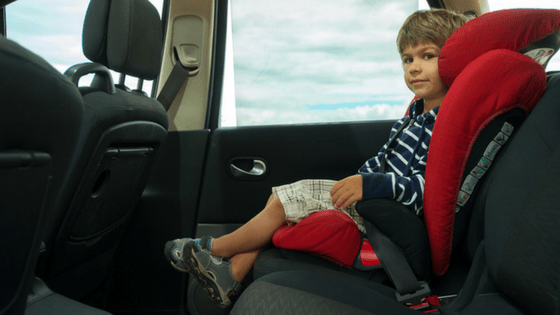It seems like only yesterday when your baby was snug as a bug in an infant car seat. Yet in a blink of an eye, your child has reached the car seat milestone and is ready for a booster seat. Transitioning from rear-facing and front-facing car seats to a booster seat takes pre-planning and important buying decisions, things you should prepare for now before your child reaches that stage.

Know When It’s Time for a Booster Seat
As children start school, they can’t wait to say goodbye to their child restraint seat system. Plus, there’s that thing called peer pressure. Depending on their weight and height, some children come out of car seats sooner than others and the peer pressure begins. But as a parent, you have the vital role of keeping your child safely secure when riding in a vehicle, despite the cries of your child to switch to a booster like all the other kids.
Many countries have regulations or guidelines to help parents determine when it’s time to transition from a car seat to a booster seat. Your child’s pediatrician is also a helpful resource.
As a general rule, a child is ready for a booster seat when he or she reaches the top weight or height limit indicated in the manufacturer’s manual of your current front-facing car seat. This can occur between the ages of four to seven. It’s important to note that some car seats have weight limits as high as 80 pounds, while the maximum weight for others is 40 pounds.
Types of Booster Seats
The goal of a booster seat is to give your child a boost in height so the seat belts in the back seat of your vehicle properly fit over the strongest parts of your child’s body, thus reducing injury during an accident.
Four types of booster seats are available:
All-in-one car seat: These types of boosters are included in a child’s seat that starts as rear-facing then transitions to forward-facing and finally to a booster as the child grows in height and weight.
Backless booster seats: These are best for vehicles with high headrests in the back seat to provide the proper head and neck support. A good measure to go by is the back seat headrest is higher than your child’s ears. Backless boosters work in tandem with your vehicle’s seat belt system. The safest backless models feature a latch connection system that is used in conjunction with the vehicle’s seat belt to provide additional stability.
High back booster seat: This type of booster is best for vehicles with low seat backs or no headrests. It provides your child with the proper head and neck support to prevent severe injuries to those areas in the event of an accident.
Combination car seat and booster: This combination seat features a forward-facing car seat that converts into a booster. It includes adjustable harness and crotch straps that adjust as the child grows.
Note that booster seats, no matter their type, are for back seat use only. Children in booster seats should never be seated in the front seat of a vehicle.

Match the Booster With Your Vehicle Type
According to child passenger safety experts, with booster seats, it’s all about proper fit, both with the seat and the seat belt, to keep your child well protected if an accident occurs.
Unlike other child safety seats that are tightly installed, booster seats are held in place by your child’s weight and your vehicle’s lap and shoulder belt system. As such, a correct fit is essential.
Proper booster seat fit in your vehicle:
- The booster must grip the seat’s surface securely;
- The booster seat should sit flat on the back seat and not wobble;
- In vehicles with low back seats or contoured seats, the booster seat should fit snugly and evenly.
Proper seat belt fit in your vehicle:
- When sitting in the booster, the vehicle’s lap belt should fit snugly across your child’s upper thighs;
- The vehicle’s shoulder seat belt should remain snug across your child’s chest and middle of the shoulder;
- There should be no slack in the shoulder belts;
- If the lap belt lies across your child’s stomach or the shoulder belt stays on the neck or face, your child is not yet ready for a booster seat.
Don’t be shy about asking to try out a booster seat in your vehicle before buying it. Often, stores have floor models for such testing.
Features to Look for in a Booster for Your Child
There are many different types and styles of booster car seats from numerous different manufacturers. To help make your booster seat decision less daunting, review the BestCarSeatHUB rating, which reviews various makes of booster seats and ranks them based on their advantages, disadvantages and opinions of people who are using them.
Additionally, there are some features to look for when buying a booster seat. These features ensure your child is well protected in the event of an accident and give you peace of mind when choosing the best booster seat for your child.
- Highly rated – Look for a booster that has good safety ratings. This means the booster seat performs well in properly positioning your child for ideal seat belt placement.
- Extra protection – Booster seats with added protection, such as energy absorbing foam and side impact protection, provide added safety, especially with high back boosters and combination seats.
- Comfortable – You want your child to be comfortable in the seat, so look for boosters that are well padded on the seat and armrests.
- Latch feature – This comes in handy when the booster is not in use to prevent it from falling off the back seat during a hard stop or becoming a projectile in the event of an accident.
- Well marked belt paths – Your child should be able to buckle in without any help by following the belt paths on the booster seat.
- Good expiration date – Some booster seat models expire six years after they have been manufactured. Be sure the booster you are buying will not expire before your child outgrows it.
- Lightweight – If you travel a lot, carpool, or share pick up and drop off duties with others, lightweight boosters are easier to use and provide more portability.
- Easy Cleaning – Some boosters have seat covers that can be easily removed and washed. This is a valuable feature for removing drink and snack stains, as well as everyday dirt.
With these tips for buying a booster seat, you’ll rest easy knowing your child is safe and secure when traveling in a vehicle.
 Kaboutjie SA Mommy Blogs by Lynne Huysamen
Kaboutjie SA Mommy Blogs by Lynne Huysamen





Great article Lynne and one that all parents should read.
I’ve noticed over the past few years that articles and awareness around car/booster seats have intensified because of the vital role these seats play in your child’s life.
And it is quite alarming to me that there are still people out there that’s not making use of this.
I had no idea that there are so many type of booster seats. I bought an infant car seat/pram combo for when JD was a baby and I bought a bigger car seat for when he outgrows the infant seat.
I did read an article the other day about how and where the car seat belt should fit the child when sitting in the booster or car seat and I paid attention to that when we switched to the bigger car seat recently.
Thank goodness, it does look like the seat we bought will be sufficient. JD transitioned to the new seat without any hassle and it seems like he is enjoying this front facing seat. He sits very quietly and is pretty well behaved at this stage. I’ve noticed that he likes to look through the window when we are travelling.